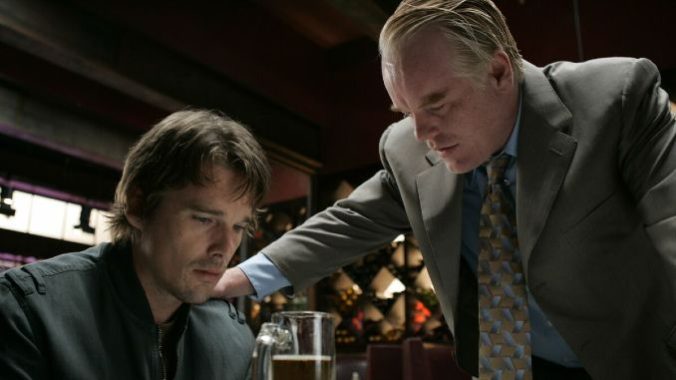Before the Devil Knows You’re Dead Sent Sidney Lumet Out on a High Note

Recently, I interviewed 80-year-old filmmaking legend Walter Hill on the occasion of his latest feature, the old-school Western Dead for a Dollar. When speaking about how this film is in conversation with his overall canon, he pivoted to how a director’s work evolves over the course of their career. “People ask you sometimes—obviously because I’m an old director—“When are you gonna retire?” I generally say directors don’t retire,” he said. “I’ve never known one that retired. Every old director I’ve ever known—and I’ve known a lot of them—was always looking to do another movie.”
You don’t often hear about directors making an intentional decision to call it a day. Steven Soderbergh takes playful jabs constantly about his retirement announcement being immediately followed by a more prolific output than just about any other working director. Quentin Tarantino has famously gotten plenty of attention for his vehement claim that his next film will be his last—a statement this writer, at least, is incredibly skeptical of.
For most directors, they don’t know when their final film is going to be their final film, and due to the nature of the industry, and the demands that come with filmmaking, there aren’t many examples of directors going out on extraordinarily high notes. “I’d be the first to say it’s a young person’s game,” Hill said. “It takes a lot of energy and focus to do these things.” More often than not, filmmakers peter out with some mid-tier work at best, or shaggy cult favorites that devoted fans hail as masterpieces primarily due to how that work reflects a filmmaker’s now-familiar pet passions.
Sidney Lumet was 83 when Before the Devil Knows You’re Dead was released in 2007, but if his name hadn’t been synonymous with cinema for the last 55 years thanks to classics like 12 Angry Men, Dog Day Afternoon, Network and so many more, you would have thought his final feature was helmed by someone half his age. With its frenetic editing, booming score, razor-sharp dialogue throwing barbs at pitiable, loathsome characters, and early adoption of digital filmmaking, Before the Devil Knows You’re Dead feels more akin to a bravura upstart making their second or third film than an old industry stalwart on his last hurrah.
The plan was so simple for financial executive Andy (Philip Seymour Hoffman) and his younger brother Hank (Ethan Hawke), a lower-level employee at the same company. Andy has been hedging funds from his books to afford the lavish lifestyle he’s gotten accustomed to with his wife Gina (Marisa Tomei), along with his addiction to cocaine and heroin. Hank, meanwhile, is scraping by in his shitty apartment, mounting debt to his ex-wife Martha (Amy Ryan) as he’s three months behind on child support payments. They both need cash fast to get them out of these depths and, unsurprisingly, it’s Andy with the lightbulb going off.
Before we learn any of this, though, we see how things are going to go disastrously awry. Before the Devil Knows You’re Dead was written by Kelly Masterson, the first feature screenplay written on spec by the award-winning playwright, and its fragmented timeline jumps from different points in the narrative as well as different character perspectives. It keeps us on our toes and offers a full scope of how each member of this family is dealing with the build-up to its central event, the event itself and the tragic aftermath. That event in question is the robbery of a small shopping center jewelry store, “between a Foot Locker and a Claire’s Accessories,” run by Andy and Hank’s parents (Albert Finney and Rosemary Harris), and those best laid plans go to waste pretty fast when the robbery leads to their mother, Nanette, suffering a fatal gunshot wound.
The verve of Masterson’s writing is reflected in Lumet’s style. A director known for a career of framing his actors and letting them go to work, there’s a lot more movement and versatility in this film’s shooting than you might expect from Lumet. That comes from the flexibility he’s given with shooting on digital. Lumet had experimented and become enamored with shooting on HD video with the short-lived early 2000s A&E legal thriller 100 Centre Street. Before the Devil would be his first time employing the new technique with a feature.
Given what a veteran Lumet was, it’s astonishing to watch or read interviews with him from the time of the film and see the spark he had when discussing this new technology. Plenty of our most acclaimed directors still refuse to shoot on anything but film, but Lumet never wanted to use it again after working with digital. In an interview on Shout! Factory’s Before the Devil Blu-ray, he explains that shooting digital was so much more convenient than the pain in the ass of working with film that he thought film would soon become obsolete. He said that anything he could get on film, he could get on digital—and get it better, quicker and cheaper.
Even in his 80s, Lumet was constantly looking for new ways to experiment and change his game; Before the Devil shows how a steady hand can take this new trick and employ it with old style. Reteaming with cinematographer Ron Fortunato, Lumet shot many scenes with two cameras rolling on different actors at the same time, allowing him to capture organic responses in the moment rather than needing to patch together coverage over different setups. This allows an even more in-your-face experience that fits appropriately within Lumet’s adoration of actors above all else.
-

-

-

-

-

-

-

-

-

-

-

-

-

-

-

-

-

-

-

-

-

-

-

-

-

-

-

-

-

-

-

-

-

-

-

-

-

-

-

-








































